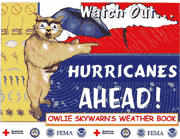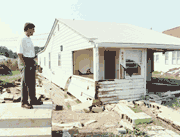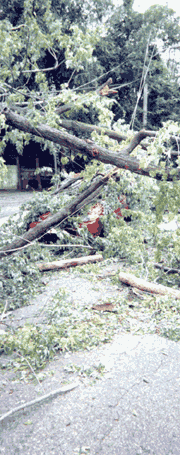|
|||
Be Ready for the Next Big Blow
|
|
Emergency and Evacuation Contacts
Do not dial 911 unless you have a life-threatening situation • Baltimore, Gas & Electric for loss of power or gas: 877-778-2222 • American Red Cross: 410-764-7000 • Anne Arundel County: Animal Control: 410-222-8900 • Anne Arundel Emergency Management Bureau: 410-222-8040 • Anne Arundel Department of Public Works, Emergency Dispatch: 410-222-8400 • Anne Arundel County Dept. of Health: 410-222-7095 • City of Annapolis Emergency Management Office: 410-268-9000 • Calvert County evacuation assistance and rides: 410-535-1600, x 2302 • Calvert County Health Department.: 301-855-1353 • Calvert County Sheriff’s Office: 301-855-1194 • Southern Maryland Electric, to have a generator hook-up installed: 888-440-3311 |
Develop a Family Plan
Suppose a hurricane watch is issued for the Chesapeake while you are away from home. Does the rest of your family know what to do or where to go? A Red Cross survey showed that less than one-quarter of the population had discussed emergency plans with their children.
Create an evacuation plan. Know where you can go — friend, family, hotel or shelter — and how each of you can get there. Lowlands may flood early, bridges may be closed and major highways could be jammed bumper to bumper, so consider those options as you plan a safe route. Contact your company, day care provider or school to get their plans.
Use government resources to develop alternate routes. FEMA offers digital and print flood maps you can use to plan escape routes. In Anne Arundel County, after Ernesto passed, over three dozen roads were blocked by tree limbs, power lines or flood waters, according to Pam Jordan, county land-use spokeswoman.
Put together a package for each family member with roadmaps, addresses and phone numbers. Use index cards and waterproof ink. Seal into a plastic bag with contact information and policy numbers for home, auto and boat insurance, medical prescriptions and credit cards. Keep some cash handy in a safe place.
Arrange a check-in with a friend or family member. Know how to use your cell phone for text messaging, which can often work when voice calls are not possible. Some cell phones have a dispatch or walkie-talkie feature that might allow family members to communicate during emergencies.
Create cards giving detailed directions about how to turn off electricity, gas and water if authorities advise you to do so. (You may need to have an expert technician to turn them back on.) Tape or place the cards where they can be seen easily.
Include Your Pets in Your Planning
Make a plan for your pets. No pets will be allowed in Calvert County emergency shelters, for health reasons. Anne Arundel County emergency shelters will accept pets, according to Alfred Cordoza of Anne Arundel Emergency Management Services, but they must be in crates or carriers, and a person must be with them at all times. Carry a photograph of you with your pet in case you are separated.
Make a pet emergency pack with food, water and medications for three days. Doggie backpacks can be prepackaged with collapsible water bowl, treats, a blanket and safety vest. Pockets that slide onto a dog/cat collar can be used for identification, prescription information and owner’s photo. Blinking lights, like those made by Guardian Gear, can be added to a pet’s collar for visibility.
Dogs and cats should have an identification collar with your name, the pet’s name, address, phone, current rabies tag and registration. Anne Arundel provides low-cost rabies vaccinations for $5 per animal on Thursdays from 1 to 4pm at Animal Control, 411 Maxwell Frye Road, in Millersville.
Survey Your Home
Look around your property outside, and make a note of all the things that could fly away under high winds. These are not just property that could be lost; they are potential missiles that could knock out windows and cause injury. Metal wind chimes and garden shovels become daggers at 65 miles per hour.
Inside, consider what things you would take if forced to evacuate. If you have many family photographs and important documents, make copies and share them with your family or community historic group; then, if the family albums are damaged, you can create new ones. For important legal documents such as wills, deeds, mortgages, adoption papers, birth certificates, car and boat titles and the like, make copies and keep the originals in a safe deposit box.
Make a photographic record of your home and property for insurance purposes. If you have jewelry, art or antiques that are especially valuable, obtain appraisals for them and keep the originals with your legal documents.
Back-up your computers on disks and take them with you. You should also carry identification (passport, driver’s license, etc.) and health records with you.
Resourcefully Avoid Panic
Being prepared helps reduce the stress of not knowing what to do; however, it can create a feeling of pending disaster. Help your family to think of a storm as a challenge rather than as a threat. Try reading books about how other people have borne the storms of their lives: Little House on the Prairie, The Swiss Family Robinson or Robinson Crusoe. Adults may find solace (and a bit of terror) in Neville Shute’s 1939 classic, The Trouble with the Corbetts a story of the trials of an English family driven from their community during the German bombing raids. Just for fun add a few episodes of MacGyver — he could solve almost anything with a knife and duct tape — or a Disney Junior Woodchuck comic, with its guidebook on how to tame the Loch Ness monster.
Part II: As a Storm Approaches Stay Informed
Listen to local access and public service radio, cable and television channels.
Emergency Alert System Radio Stations: Primary, wbal-am 1090. Secondary, wnav-am 1430; wyre-am 810; wann-am 1190; wrnr-fm 103.1; wfsi-fm 107.9.
If you have Internet access, local webcams can be used to assess local roads and water height at Annapolis City Dock. Television stations will run emergency banner alerts. Citizens in Anne Arundel County can call the Office of emergency Management: 410-222-8040.
The NOAA Weather website offers maps, discussions and other information about storms. NOAA also provides county specific weather radio information: Anne Arundel County, kec83 162.4 and wxk97 162.5. Calvert County, kec83 162.4, khb36 162.55 and kec92 162.475.
|
Hurricane Resources for Kids
 1 The Federal Emergency Management Association offers information and quizzes on the history of hurricanes, classification and tracking: fema.gov/kids/hurr.htm. 2 National Geographic Kids includes a video where you can fly into the eye of a hurricane: www.nationalgeographic.com/ngkids/0308/hurricane/index.htm. 3 The National Hurricane Center offers printable posters and lots of practical information: www.nhc.noaa.gov/HAW2/english/kids.shtml). 4 The National Weather Service Kids page includes Owlie Skywarn, who teaches children about weather signals: www.weather.gov/om/reachout/hurricane.shtml. 5 The Canadian Hurricane Center uses Hurricane Harry to explain all about hurricanes and their impact. The hurricane word search also teaches children storm terminology: www.atl.ec.gc.ca/weather/hurricane/kids.html. 6 Hurricane Survival for North Carolina residents includes classroom assignments: www.unctv.org/hurricane/forkids.html. 7 Children’s books about hurricanes include: Yesterday We had a Hurricane by Deidre McLaughlin Mercier; Sergio and the Hurricane by Alexandra Wallner; Hurricane! by Jonathon London; and Hurricanes: Earth’s Mightiest Storms by Patricia Lauber. |
Stay Safe
Keep your car at least three-quarters full of gas; power outages may affect gas stations and waiting in line could cause dangerous delays. Check your tires, oil and battery; include an extra quart of oil in addition to a portable battery charger or jumper cables. Park in a protected area as close to your residence as possible and away from power lines and trees. Even if you don’t evacuate, you might need your car radio.
Fill your bathtub with water and turn off and unplug unnecessary appliances and lamps. Stay indoors away from windows and glass and close all interior doors. Secure and brace all external doors. Take refuge in a small interior room, closet or hallway on the lowest level. Do not go out as the eye of a storm passes; you may not have enough time to get back to safety.
Know your designated shelter and evacuation routes.
In Anne Arundel County call 410-222-0600 or listen to emergency radio broadcasts.
Calvert County Shelters: Calvert County High School at Dares Beach Road and the Solomons Volunteer Fire & Rescue Company on Route 2/4. If necessary, an additional reception center will be opened at Hughesville Volunteer Fire Department, Route 231 in Charles County.
Nearly half of all flood fatalities are related to vehicles. Never walk or drive into waters where you cannot see the road. Learn and teach your family the National Weather Service rhyme to reinforce that point: Turn around, don’t drown.
Part III: After the Flood Clean Up
Don’t play in floodwaters; they may contain toxic chemicals, oils or sewage waste. Wash separately all clothes that come into contact with storm waters.
Floodwaters may include sewage and dead animals, so cleaning should be as thorough as possible. Disinfect floors, counters and shelves with a solution of one cup bleach per five gallons water. Upholstered furniture should be rinsed with fresh, clean water, air-dried and treated with a disinfectant. Drywall and insulation may need to be cut out, thrown away and replaced. All electrical equipment must be completely dry before it can be used.
Throw away all perishable or unsealed food. Throw away any item that cannot be disinfected; this includes any food containers with tops that are screwed or crimped, like beer and soda bottles, or that snap, twist or flip open. If cans have come into contact with floodwater, remove the labels, wash in soapy water then dip in a solution of one cup bleach per five gallons water. Relabel cans with a permanent marker.
Wear gloves and boots when cleaning up floodwater, and use disinfectant before eating. If you have a lot of clothing and household linens to wash, consider using a laundromat; your home water system should not be overloaded when the ground is soaked from flood or storm water.
All wells should be disinfected (see sidebar). During Hurricane Isabel, the Anne Arundel County Health department fielded over 8,000 calls, mostly on how to disinfect water supplies. In an emergency you might not be able to get through to ask.
|
How to Disinfect (Chlorinate) Your Well
 1. Before you start this process, draw off several full buckets of water (or fill the bathtub) to use for flushing the toilet for the next 24 hours. 2. Turn off any water conditioning equipment. 3. Remove the well cap, and pour one gallon of bleach into a driven or drilled well; two gallons for a dug well. 4. Using a garden hose hooked to an outside spigot, place the hose inside the well. Turn the water on at the tap and allow water to circulate for two hours. Turn the water off, remove the hose and replace the well cap. 5. Turn on each tap in the house, hot and cold, one at a time. Immediately turn off the tap as you detect the odor of chlorine or notice milky water. Allow chlorine to remain in the system for 24 hours, minimum. Do not use heavily chlorinated water for bathing, laundering or washing sterling silver. 6. Turn on an outside garden hose and allow water to run until the chlorine odor has completely disappeared. Caution: Do not run the chlorinated water into your septic system; it may overload its capacity. Removing chlorinated water from the well may take two to three days. 7. Follow-up bacteriological testing is recommended by a state-certified private laboratory or by the Maryland Department of Health and Hygiene: 410-222-7189. If you have a water-treatment system, contact your water conditioning company before reconnecting. Chlorine can damage your water-treatment system. |
Wash and Reorient Your Pets
Thoroughly shampoo any pets that have been swimming or playing in floodwater. If your home has been flooded, you may need to keep your dog on a leash on walks until all the new smells and scents are recognized. Cats may become disoriented as well and should be treated as if you had just moved.
Freelance journalist Kat Bennett writes on issues from entertainment to environment to science. Hurricane watchers will remember her story last year, “When Will the Bay Flood Again?” (Vol. xiii, No 36: September 8, 2005).




